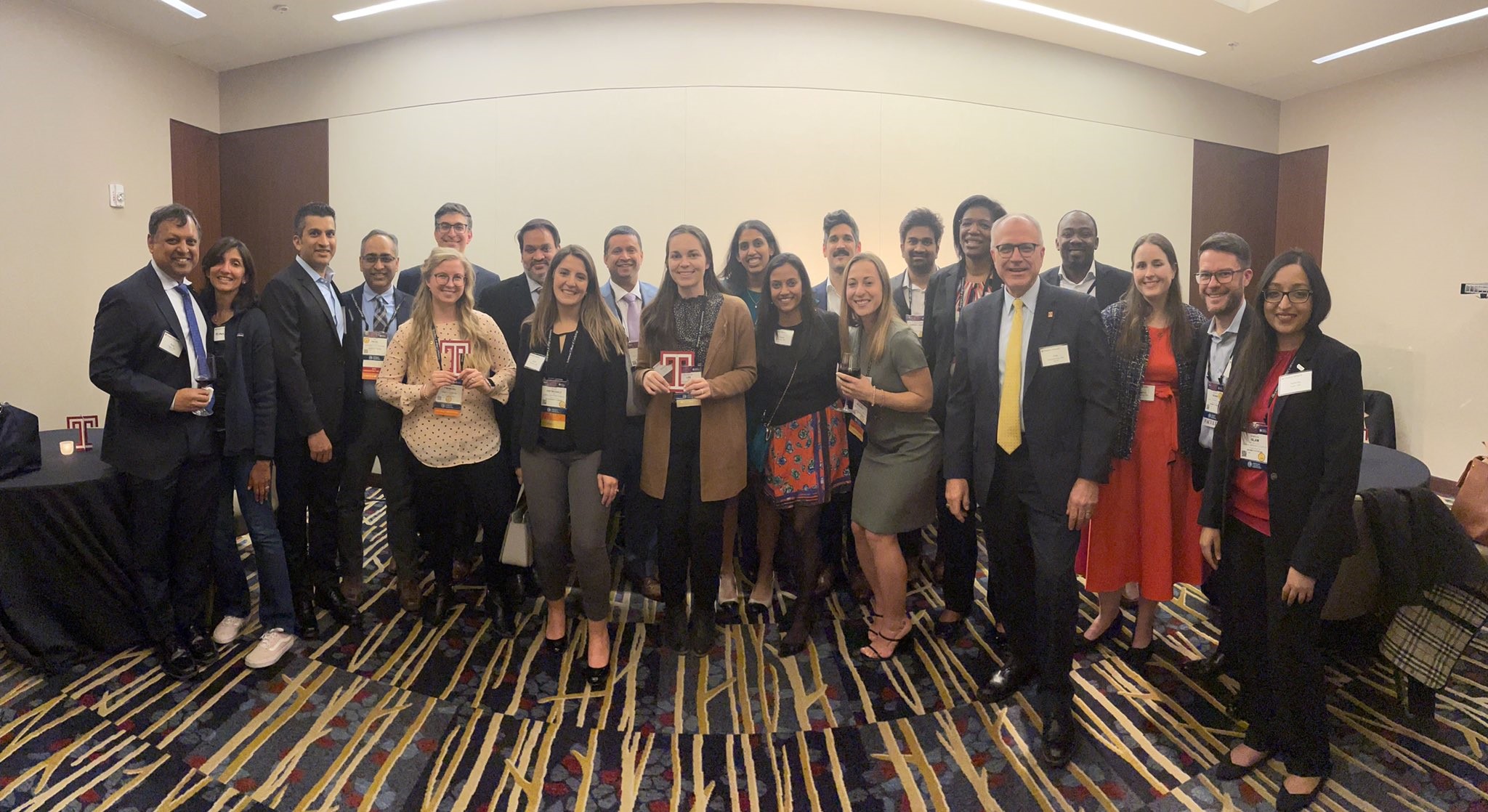Current Fellows
First-Year Fellows
Deanna Gill, MD
Residency: Emory University, Atlanta, GA
Medical School: Sidney Kimmel Medical College at Thomas Jefferson University
Interests: Heart Failure, Critical Care, Cardiac Imaging
Maani Kamal, MD
Residency: The Hospital of the University of Pennsylvania, Philadelphia, PA
Medical School: University of Alabama School of Medicine
Interests: Healthcare Disparities and Cardiovascular Outcomes, Critical-Care, and Medical Education
Shreya Makkapati, MD
Residency: Temple University Hospital, Philadelphia, PA
Medical School: New York Medical College
Interests: Advanced Imaging, Prevention, Heart Failure, Quality Improvement
Rohit Pillai, MD
Residency: Beth Israel Deaconess Medical Center, Boston, MA
Medical School: Boston University
Interests: Preventive Cardiology, Imaging, Medical Education
Jackson Walker, MD
Residency: University of Cincinnati, Cincinnati, OH
Medical School: Sidney Kimmel Medical College at Thomas Jefferson University
Interests: EP, Heart Failure, Cardiogenic Shock, Medical Education
Second-Year Fellows
Rylie Pietrowicz, MD
Residency: Temple University Hospital, Philadelphia, PA
Medical School: Cooper Medical School of Rowan University
Interests: Heart Failure, MCS and Cardiac Imaging
Rohit Maruthi, MD
Residency: Temple University Hospital, Philadelphia, PA
Medical School: Boston University, Boston, MA
Interests: Interventional Cardiology, Critical Care, MCS
Madeline Lee, MD
Residency: Temple University Hospital, Philadelphia, PA
Medical School: Lewis Katz School of Medicine at Temple University
Interests: Heart failure, MCS and Echocardiography
Gregory Troutman, MD , MBE
Residency: Hospital of the University of Pennsylvania, Philadelphia, PA
Medical School: Sidney Kimmel Medical College at Thomas Jefferson University
Interests: Prevention, Multimodality Imaging, and Bioethics
Loveleen Bhogal, MD
Residency: Medstar Washington Hospital Center/Georgetown University, Washington DC
Medical School: Kasturba Medical College Manipal, India
Interests: Electrophysiology and Advanced Imaging
Third-Year Fellows
Matthew Bocchese, MD
Residency: Temple University Hospital, Philadelphia, PA
Medical School: Sidney Kimmel Medical College at Thomas Jefferson University
Interests: EP, Imaging, Medical Education
Naima Maqsood, MBBS
Residency: Temple University Hospital, Philadelphia, PA
Medical School: Aga Khan University Medical College
Interests: Hemodynamics, Medical Education, Cardiac Arrest and Cardiopulmonary Resuscitation outcomes
Rahul Jaswaney, MD
Residency: Case Western Reserve University/University Hospitals Louis Stokes Cleveland Veterans Affairs Hospital, Cleveland, OH
Medical School: University of North Carolina, School of Medicine
Meghana Patil, MD
Residency: Cleveland Clinic Foundation, Cleveland, OH
Medical School: Lewis Katz School of Medicine at Temple University
Interests: Coronary disease, Structural Heart Disease, Cardiac Critical Care
Alisha Jamil, MD
Residency: University of Pennsylvania, Philadelphia, PA
Medical School: Perelman School of Medicine at the University of Pennsylvania
Interests: Heart failure, Women's Health, Medical Education
Fellowship Alumni
Electrophysiology Fellowship - Hospital of the University of Pennsylvania
Electrophysiology Fellowship - Massachusetts General Hospital
Electrophysiology Fellowship - Temple University Hospital
Cardiology - Penn Presbyterian Medical Center, Philadelphia, PA
Cardiology - Inova Medical Center, Fairfax, VA
Electrophysiology Fellowship – Lankenau Medical Center, Wynnewood, PA
Advanced Heart Failure Fellowship – University of Michigan, Ann Arbor, MI
Cardiology – Pennsylvania Hospital, Philadelphia, PA
Class of 2020
Interventional Cardiology Fellowship – Yale University, New Haven, CT
Advanced Heart Failure Fellowship – Medstar Washington Hospital Center, Washington, DC
Interventional Cardiology Fellowship – Lankenau Medical Center, Wynnewood, PA
Advanced Cardiac Imaging Fellowship – University of California San Diego, San Diego, CA
Private Practice – Egg Harbor Twp, NJ
Class of 2019
Electrophysiology Fellowship – Temple University Hospital, Philadelphia, PA
Interventional Cardiology Fellowship – University of Pittsburgh Medical Center, Pittsburgh, PA
Structural Heart Disease Fellowship – University of Pittsburgh Medical Center, Pittsburgh, PA
Advanced Heart Failure Fellowship – Northwestern University, Chicago, IL
Advanced Cardiac Imaging Fellowship – Northwestern University, Chicago, IL
Class of 2018
Advanced Cardiac Imaging Fellowship – Mt. Sinai Hospital, New York, NY
Electrophysiology Fellowship – Temple University Hospital, Philadelphia, PA
Private Practice – Pittsburgh, PA
Private Practice – Philadelphia, PA
Class of 2017
Interventional Cardiology Fellowship – Temple University Hospital, Philadelphia, PA
Peripheral Vascular Fellowship – Mass General Hospital, Boston, MA
Electrophysiology Fellowship – Temple University Hospital, Philadelphia, PA
Critical Care Fellowship – Yale New Haven Hospital, New Haven, CT
Advanced Heart Failure Fellowship – Mount Sinai Hospital, New York, NY
Class of 2016
Advanced Heart Failure Fellowship – MedStar Washington Hospital Center, Washington, DC
Advanced Heart Failure Fellowship – NY Presbyterian Hospital – Cornell, New York, NY
Interventional Cardiology Fellowship – University of Florida Hospital, Jacksonville, FL
Private practice – North Dakota
Class of 2015
Interventional Cardiology Fellowship – Thomas Jefferson University Hospital, Philadelphia, PA
Peripheral Vascular Fellowship – Brown University Hospital, Providence, RI
Interventional Cardiology Fellowship – University of Washington Medical Center, Seattle, WA
Structural Heart Disease Fellowship – University of Washington Medical Center, Seattle, WA
Electrophysiology Fellowship – Temple University Hospital, Philadelphia, PA
Private Practice – Pennsylvania
Class of 2014
Advanced Cardiac Imaging Fellowship – University of Virginia, Charlottesville, VA
Interventional Cardiology Fellowship – University of Rochester, Rochester, NY
Structural Heart Disease Fellowship – Mayo Clinic, Rochester, MN
Interventional Cardiology Fellowship – UCLA-Harbor, Torrance, CA
Private Practice – Pennsylvania
Class of 2013
Electrophysiology Fellowship – Lankenau Medical Center, Wynnewood, PA
Interventional Cardiology Fellowship – Brown University Hospital, Providence, RI
Interventional Cardiology Fellowship – MedStar Washington Hospital Center, Washington, DC
Electrophysiology Fellowship – MedStar Washington Hospital Center, Washington, DC


